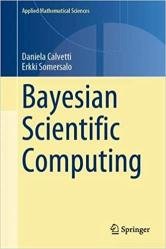 Название
Название: Bayesian Scientific Computing
Автор: Daniela Calvetti, Erkki Somersalo
Издательство: Springer
Серия: Applied Mathematical Sciences
Год: 2023
Страниц: 295
Язык: английский
Формат: pdf (true), epub
Размер: 38.1 MB
The once esoteric idea of embedding scientific computing into a probabilistic framework, mostly along the lines of the Bayesian paradigm, has recently enjoyed wide popularity and found its way into numerous applications. This book provides an insider's view of how to combine two mature fields, scientific computing and Bayesian inference, into a powerful language leveraging the capabilities of both components for computational efficiency, high resolution power and uncertainty quantification ability. The impact of Bayesian scientific computing has been particularly significant in the area of computational inverse problems where the data are often scarce or of low quality, but some characteristics of the unknown solution may be available a priori. The ability to combine the flexibility of the Bayesian probabilistic framework with efficient numerical methods has contributed to the popularity of Bayesian inversion, with the prior distribution being the counterpart of classical regularization. However, the interplay between Bayesian inference and numerical analysis is much richer than providing an alternative way to regularize inverse problems, as demonstrated by the discussion of time dependent problems, iterative methods, and sparsity promoting priors in this book. The quantification of uncertainty in computed solutions and model predictions is another area where Bayesian scientific computing plays a critical role. This book demonstrates that Bayesian inference and scientific computing have much more in common than what one may expect, and gradually builds a natural interface between these two areas.
Particle filters, Kalman filters and Ensemble Kalman filters combine, in an elegant and organic way, many of the Bayesian scientific computing topics introduced in the earlier chapters. The evolution and observation equations can be interpreted as prior and likelihood, and the way in which the posterior is updated from one time step to the next resembles the natural learning process. Likewise, sampling methods have a more prominent position, commensurate with their key role in many Bayesian scientific computing tasks. The rational for Monte Carlo integration in high dimensions is an excellent example of the need for sampling from a distribution, and is used here as a gateway to some of the most popular sampling schemes, including the intuitive importance sampling, the classical Gibbs sampler and Metropolis–Hastings algorithms, all the way to the clever preconditioned Crank–Nicolson sampler.
Contents:
1. Bayesian Scientific Computing and Inverse Problems
2. Linear Algebra
3. Continuous and Discrete Multivariate Distributions
4. Introduction to Sampling
5. The Praise of Ignorance: Randomnessas Lack of Certainty
6. Enter Subject: Construction of Priors
7. Posterior Densities, Ill-Conditioning,and Classical Regularization
8. Conditional Gaussian Densities
9. Iterative Linear Solvers and Priorconditioners
10. Hierarchical Models and Bayesian Sparsity
11. Sampling: The Real Thing
12. Dynamic Methods and Learning from the Past
13. Bayesian Filtering for Gaussian Densities
Скачать Bayesian Scientific Computing
[related-news]
[/related-news]